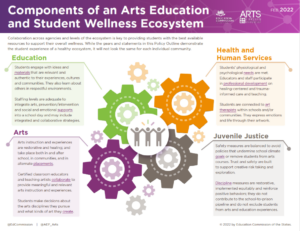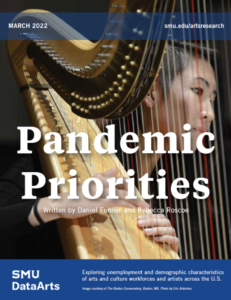April
2022
April 5, 2022
From the Field
Community Planning and the Arts in Indiana
 A new report on arts and economic development in Indiana, Planning with Arts & Culture, has been produced for the Indiana Arts Commission (IAC) by Ball State University. The report surveyed Indiana municipal government leaders, tourism offices and community foundation offices to better understand how communities perceive and work with arts, culture and economic development. The responses suggest that a majority of respondents believe arts and culture play an important role in community and economic planning initiatives. The report includes a breakdown of responses based on rural-urban location and offers recommendations for expanding IAC’s arts and economic development programming.
A new report on arts and economic development in Indiana, Planning with Arts & Culture, has been produced for the Indiana Arts Commission (IAC) by Ball State University. The report surveyed Indiana municipal government leaders, tourism offices and community foundation offices to better understand how communities perceive and work with arts, culture and economic development. The responses suggest that a majority of respondents believe arts and culture play an important role in community and economic planning initiatives. The report includes a breakdown of responses based on rural-urban location and offers recommendations for expanding IAC’s arts and economic development programming.
Arts Education and Student Wellness
 Components of an Arts Education and Student Wellness Ecosystem is a two-page resource from the Arts Education Partnership that provides an overview of policies and actions at the local, state and federal levels. The resource focuses on arts, cross-agency collaboration and the education and student wellness ecosystem. When integrated into the education ecosystem, the arts can provide students with opportunities for creative engagement and expression that support students’ overall wellness. Intended to spark discussion, this resource links to many other resources, including 10 Questions for Reflection and Action on the second page, to assist in further exploring this vision for connected communities.
Components of an Arts Education and Student Wellness Ecosystem is a two-page resource from the Arts Education Partnership that provides an overview of policies and actions at the local, state and federal levels. The resource focuses on arts, cross-agency collaboration and the education and student wellness ecosystem. When integrated into the education ecosystem, the arts can provide students with opportunities for creative engagement and expression that support students’ overall wellness. Intended to spark discussion, this resource links to many other resources, including 10 Questions for Reflection and Action on the second page, to assist in further exploring this vision for connected communities.
Pandemic-Era Arts Funding: 2020
SMU DataArts’s new article, Studying Early Pandemic Data: Which Funding Sources Stepped Up for the Arts? explores the increase in unrestricted contributed revenue in 2020, which was driven by revenue contributions from diverse arts funders. The donated revenue reversal in 2020 covered more than half of the average arts and cultural organization’s annual expenses, leaving a 2% surplus of unrestricted funds. There were modest increases in individual and foundation giving, but contributions from the federal government—through programs supported by the Coronavirus Aid, Relief and Economic Security Act—accounted for a sizable percentage of this growth in the early months of the pandemic. This post also discusses governmental support for workforce retention and trends in unemployment rates in the arts and culture sector.
Arts and Culture Unemployment, Revival during Pandemic
 Two additional reports released by SMU DataArts explore how the COVID-19 pandemic has affected the arts. The first, Pandemic Priorities, examines unemployment and demographic characteristics of arts and culture workforces and artists across the United States. Using its own decade-long survey and data from the U.S. Bureau of Labor Statistics, SMU DataArts finds that unemployment in the arts was double that of overall national unemployment, and BIPOC (Black, Indigenous and/or people of color) and individuals with disabilities were disproportionately affected. The second report, Two Years On, is part of a larger project called the COVID-19 Sector Benchmark Dashboard, conducted by TRG Arts and Purple Seven. Findings reveal that there was significant variation in the pace of revival among arts organizations in the United States, and that music venues in the sample performed substantially better than theatres in 2021. The report also finds that advance booking patterns in the United States in 2021 were very similar to 2019.
Two additional reports released by SMU DataArts explore how the COVID-19 pandemic has affected the arts. The first, Pandemic Priorities, examines unemployment and demographic characteristics of arts and culture workforces and artists across the United States. Using its own decade-long survey and data from the U.S. Bureau of Labor Statistics, SMU DataArts finds that unemployment in the arts was double that of overall national unemployment, and BIPOC (Black, Indigenous and/or people of color) and individuals with disabilities were disproportionately affected. The second report, Two Years On, is part of a larger project called the COVID-19 Sector Benchmark Dashboard, conducted by TRG Arts and Purple Seven. Findings reveal that there was significant variation in the pace of revival among arts organizations in the United States, and that music venues in the sample performed substantially better than theatres in 2021. The report also finds that advance booking patterns in the United States in 2021 were very similar to 2019.
Arts and Adolescent Behavior
Jessica K. Bone, et al., with funding from a National Endowment for the Arts Research Lab, have published new research on the impact of arts and culture on adolescent behavior. Arts and Cultural Engagement undertakes a large-population, longitudinal study to explore how everyday arts and cultural engagement affects adolescent behaviors of self-control and attitude toward antisocial and criminal activities. The research finds that everyday interaction with arts and culture can potentially be used in strategies to reduce antisocial or criminalized behaviors.
In this Issue
From the President and CEO
State to State
Legislative Update
The Research Digest
Announcements and Resources
More Notes from NASAA
SubscribeSubscribe
×
To receive information regarding updates to our newslettter. Please fill out the form below.
